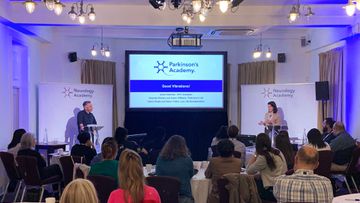Diagnosing the scent of Parkinson’s disease with mass spectrometry and Joy
Event reportsOur seventh Parkinson's Cutting Edge Science conference took place on 19th March 2024 in Birmingham and was chaired by Prof Emily Henderson and Dr Neil Archibald. You can read an overview of the entire event here.
This write up is one of a series covering each session in detail for those who were unable to attend, or want to reflect on what they heard. Read more session write ups here.
The Parkinson’s smell study, which investigated the scientific merit behind one woman’s claim to have “smelt” the disease on her husband years after his diagnosis, attracted worldwide media attention when it was published in 2019.
The work, led by professor of neurology at Manchester Centre for Clinical Neurosciences, Monty Silverdale, demonstrated it was possible to diagnose Parkinson’s by analysing the chemicals deposited in sebum. His team’s subsequent work suggests it may be possible to detect the disease earlier – and even prevent the neuron loss that drives progression.
The scent of Parkinson’s
Back in 1982 Joy Milne, a retired nurse from Scotland and so-called “super smeller”, noticed an unusual smell on her husband, Les. In the early 1990s, he was diagnosed with Parkinson’s, and when the couple started attending Parkinson’s UK meetings, Joy noticed the same, musky scent on their fellow attendees.
It was at one of these meetings in 2012 where she approached Professor Tilo Kunath, and asked if people with Parkinson’s had a musty smell, explained Prof Silverdale. “He took her seriously and decided to test her out,” he said. “He got 12 people, six with Parkinson’s and six without, to wear t-shirts overnight, and asked Joy to smell them.”
Joy correctly identified all six shirts worn by people with Parkinson’s, as well as one of the control shirts. Eighteen months later, the person who had worn the incorrectly identified control shirt was diagnosed with Parkinson’s.

“She was incredibly accurate. Clearly there was something in this, something in the skin chemicals that is different in Parkinson’s,” said Prof Silverdale, adding that the smell was emanating from the neck and upper back.
This suggested, he explained, that its source was serum. “We've known for almost 100 years that serum is increased and abnormal in Parkinson's disease,” he added.
Replicating Joy’s nose[1]
The next step was replicating Joy’s nose in order to answer three key questions: are skin chemicals different in PD, could this information inform the development of a diagnostic test, and could this test be used to diagnose the condition much earlier.
With funding from Parkinson’s UK and the Michael J Fox Foundation, the researchers collected skin swabs of serum samples from 65 untreated people from 25 UK sites.
They then used metabolomics, or Thermal Desorption Gas Chromatography Mass Spectrometry and advanced statistics, to identify all the volatile chemicals in the swabs and calculate how they differed between people with Parkinson’s and controls.
“We were able to diagnose Parkinson’s with 90% accuracy simply by using the skin swabs,” said Prof Silverdale.
There were four analytes of interest, all of which were lipids. Levels of eicosane, octadecanal, and hippuric acid, were all higher in people with Parkinson’s than controls, and perillic aldehyde was lower. Together, they create a “signature scent”.
When the resulting paper, Discovery of Volatile Biomarkers of Parkinson’s Disease from Sebum, was published, it attracted widespread attention, culminating in Joy and Prof Silverdale appearing in a BBC Scotland documentary and on BBC Breakfast.
A window to dysregulation
Despite being closed down for 18 months over the COVID period, the study has grown in the years since Prof Silverdale’s media fame. It now has more than 2,000 participants from the UK, Austria, Germany, the Netherlands, Africa, and America.
“We got the sensitivity and specificity of the skin swab test to over 95%, so it really is very accurate, at least in our hands in our lab,” said Prof Silverdale.
The team have also published a study that used liquid chromatography to examine the full range of chemicals on the swabs, rather than just the volatile ones. A pathway analysis revealed that various mitochondrial pathways, including the carnitine shuttle, were dysregulated on the swabs of those with Parkinson’s.[2]
“The fascinating thing is that when other people have done this exact same work using postmortem brain tissue, they have seen exactly the same chemical pathways dysregulated in the brain,” said Prof Silverdale, explaining that lipids are able to cross the blood brain barrier. “It’s almost like by swabbing the sebum, we are getting a window into the dysregulation of the mitochondrial metabolism.”
There is huge potential, then, to use sebum as a diagnostic fluid.
“We are now starting to realise that if you get some kind of biochemical reaction or dysregulation in the body, it leads to changes in chemicals in the sebum. These chemicals seem to get trapped there for weeks and weeks and weeks,” said Prof Silverdale. “We may have stumbled across a whole new way of Parkinson's and other diseases.”
Next steps
The team is now hoping to extend the use of the skin swab method in numerous ways.
Assisting with triage, for example, could make a huge difference to the hundreds of undiagnosed people with Parkinson’s currently waiting for a neurology appointment. The team is collaborating with Wythenshawe Hospital on a validation study, to ensure their equipment and processes can return the same level of sensitivity and specificity as those used by Prof Silverdale’s researchers.
They are also hoping to help set up skin swab clinics in rural Africa, where the incidence and prevalence of Parkinson’s mirrors that of the UK, but there are “very few doctors and almost no Parkinson’s specialists”. “There are tens of thousands of people with Parkinson's in parts of rural Nigeria, Tanzania, and Kenya, who never get a diagnosis or any treatment,” said Prof Silverdale.
They are also investigating how the method can aid early diagnosis. “We tend not to diagnose Parkinson's until people present with mobility issues, and by then they have lost about 70% of the neurons in the substantia nigra,” said Prof Silverdale. But Joy was able to smell Les’ Parkinson's 12 years before he developed any mobility symptoms.
Much earlier diagnosis, he said, could open the possibility of using any future neuroprotective agents before the damage has been done, and dramatically improving outcomes.
“It could be a step towards prevention, or even a cure, for Parkinson’s,” he concluded.
References
Trivedi, D. K., Sinclair, E. et al. (2019). Discovery of volatile biomarkers of Parkinson’s disease from sebum. ACS central science, 5(4), 599-606.
Sinclair, E., Trivedi, D., et al. (2020). Sebum: a window into dysregulation of mitochondrial metabolism in Parkinson’s disease.

This meeting is designed and delivered by the Parkinson’s Academy and sponsored by BIAL Pharma. The sponsor has had no input into the educational content of this meeting.
Related articles
'The things you can't get from the books'
Parkinson's Academy, our original and longest running Academy, houses 23 years of inspirational projects, resources, and evidence for improving outcomes for people with Parkinson's. The Academy has a truly collegiate feel and prides itself on delivering 'the things you can't get from books' - a practical learning model which inspires all Neurology Academy courses.








